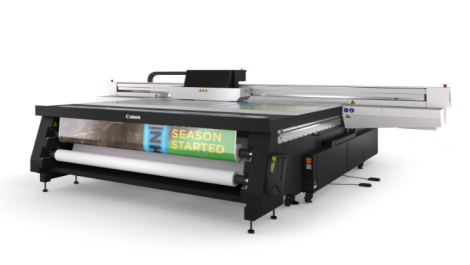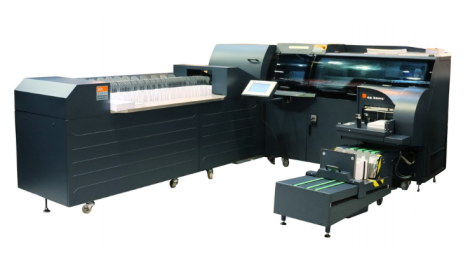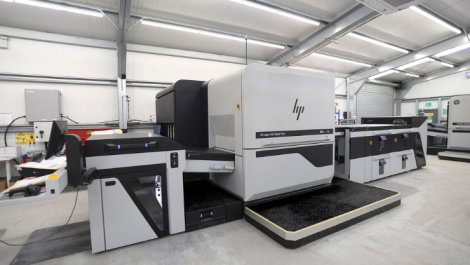The company behind the Truprint photo brand is reshaping itself to offer trade photo and commercial work online. Simon Eccles reports.
One of the largest UK based digitally printed photo products producers is Harrier LLC, which is the production house behind the Truprint brand. It also handles ‘white label’ production and fulfilment for work for a number of high street brands and is one of the output houses for HP’s Snapfish online photo service.
In a bid to even out the seasonal nature of consumer-oriented photo work, the company has moved into trade services, first with its photo products but this year adding commercial print work to its offerings.
It is based in Newton Abbot, about halfway between Exeter and Torquay in Devon. It has seven HP Indigo presses as its main production systems, thought to be the UK’s largest Indigo installation on a single site.
The company is a division of District Photo Inc, based in the USA, which claims to be the world’s largest direct-to-consumer photo fulfilment operation. DPI was set up in 1949 as a small black and white photo lab, and grew over the next half century to become a large wholesale photofinishing lab serving, retailers and a with a mail order film developing business.
In 1998 it bought its largest competitor Nashua Photo, which already owned Harrier in the UK. Three years later District Photo bought Snapfish, one of the first online photo services, but sold it on to HP in 2005. However it is still a service provider to Snapfish. Having moved into digital photo products in 2004 it is now one of the largest Indigo users in the world, with some 50 presses in two US sites.
In the UK Truprint is still offering developing and printing of silver halide films, though this is a much smaller proportion of its business nowadays. The rapid growth to dominance of digital cameras over the past decade saw it add digital print services.
Photo opportunities ‘The photo market is ripe with new business opportunities,’ says Julian Marsh, business development consultant for the company.
The Truprint website offers a huge variety of photoproducts, from straight prints through photobooks, calendars, greetings cards, mugs, posters, stamps, stationery, canvas prints and acrylic blocks. All are produced inhouse, mostly on the Indigo presses, but with wide format Canon inkjets used for the canvas prints and small format Mimaki UJF-3042 UV inkjets used for acrylic blocks.
A wide variety of finishing equipment is used, mainly supplied through Duplo or Intelligent Finishing Solutions (IFS). Photo books are perfect bound with PUR gluing for soft covers or hard covers with casing-in. There is some saddle stitching used, though not for photobooks. Wire-o is used for canvas and flip books. Lay flat books are also produced using Mitamax equipment. ‘We’ve invested heavily in skilled finishing staff,’ says Mr Marsh. ‘One of our bookbinders has about 30 years’ experience.’
The Truprint service uses the Snapfish platform, while Harrier’s white label retail clients have tended to develop or buy in their own online shopping software. Last year Harrier also adopted Taopix Photobook software for its move into trade work, offering it to its clients as an easy to implement, customisable photo design and ordering software.
‘The fully-branded photo service invites customers to create the photo product of their choice by downloading Taopix software – branded by the operating company – and then submit their product for printing,’ Mr Marsh says. Taopix is in the process of introducing new Portfolio software, and Harrier will implement this when it’s ready he says.
One publicly announced user of Harrier’s service is Saga, the over 50s holiday and insurance specialist, which last year started offering its customers an array of photo products under the name Camerabooks, backed by the Taopix software. Uploaded orders are sent to Harrier for production and fulfilment.
‘We believe that the demographic of Saga’s customers provides a great opportunity for the sale of photo products,’ Mr Marsh said. ‘We’ve used the Taopix platform to develop a great application that is branded for Saga throughout, from the desktop icon to the shopping cart, so their customers feel comfortable dealing with a brand they know.’ In the first couple of months some 1700 photo books and other goods were produced.
Although photobooks tend to be most associated with online ordering, Mr Marsh says that digitally printed custom calendars are a major selling line. The problem is that nearly all calendar orders come in during the fourth quarter or the year, mainly in December.
‘The biggest challenge is this peak demand,’ Mr Marsh explains. ‘You need to be able to gear up for it even when it’s not being used. So we’re looking to capitalise on this all year round. Not just the hardware, but the people and their training. Trade photo books is one way we’re doing this, and we’re getting a good response.’
With the trade photo service established, Harrier’s next move was to offer general commercial trade printing, beginning early this year. Backing this is a Tharstern Primo MIS with online quotation to customers. ‘We can compete with offset up to 500 to 700 copies,’ Mr Marsh says. But if we personalise then offset can’t do it, so we are introducing the idea of 20,000 runs.
Premier ambitions
‘The main message though is that Harrier has gone from being the UK’s number one mail order analogue photo finisher to the UK’s number one photo prints and photo gifts manufacturer,’ he says.
‘Next we want to become one of the UK’s premier commercial digital printing companies. Given our unrivalled Indigo print capacity, comprehensive range of finishing equipment and highly skilled workforce we have a good chance of success. We continue to build our photo business whilst developing what we have called our new commercial division, which deals with the printing requirements of businesses rather than consumers.’
Contact: www.harrierllc.co.uk
Beating the Vatman
Last November Harrier Truprint won a landmark court case with HMRC, which saw photo books confirmed as zero rated for VAT, the same as ‘normal’ text books, rather than blank photo albums which are subject to standard rate. As a result the court ordered HMRC to repay some £545,800 to cover VAT payments made from 2006 to 2009.
Finance director Graham Clark said the case was very significant not only for Harrier Truprint, but for the photo book industry as a whole: ‘At a stroke, the Courts have erased all the legal uncertainty that previously existed, deciding once and for all that a picture does in fact paint a thousand words.’




